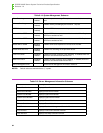
OCPRF100 MP Server System Technical Product Specification
Revision 1.0
90
8. Peripheral Bay Backplane Board
This chapter describes the features and functionality of the peripheral bay backplane board,
which is also referred to as the backplane. The backplane is designed in compliance with the
SCSI Command Set For Enclosure Services Document Specification, and SCSI Accessed Fault-
Tolerant Enclosures Interface Specification.
Features
The backplane supports the following features:
• Single channel maximum of two 1-inch or 1.6-inch low-voltage differential signal (LVDS)
SCSI (16-bit) drives and one 8-bit SCSI device.
• Single connector attachment (SCA-2) connectors to simplify insertion and removal of
hard disk drives.
• Insertion and removal of hard drives during power on (hot swap).
• LED indicators for each drive.
• Field effect transistor (FET) power control for each hard drive.
• FET short protection.
• Microcontroller to monitor enclosure services.
• I
2
C bus for management information.
• Flash memory for upgrading firmware.
• Temperature sensing.
• Programmable logic device (PLD) reprogrammability.
• SCSI accessed fault-tolerant enclosures (SAF-TE).
• Tolerant of baseboard management controller (BMC) failure.
• Supports SCSI-3 (LVDS SCSI) and SCSI-2.
• LVD/SE multimode support.
• IDE/FD connections on board.
8.1 Peripheral Bay Backplane Overview
The backplane will be an LVDS SCSI design. The single backplane has one channel with SAF-
TE and microcontroller with a capacity of two drives maximum, either 1.0 or 1.6 inches tall and
3.5 inches wide.
The backplane incorporates indicator LEDs. These LEDs will indicate drive power (green), drive
activity (green), and drive fault (yellow). A light pipe will transmit the LED indicators from the
backplane to the front bezel.


















